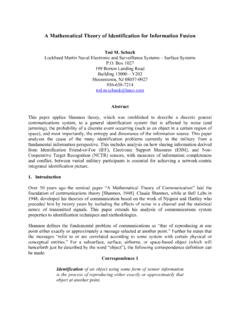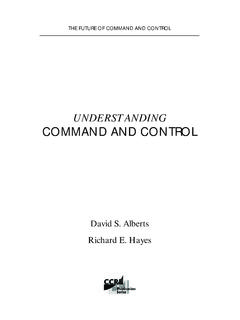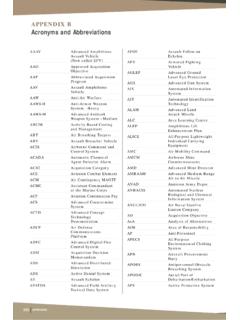Transcription of DoD C4ISR Cooperative Research Program
1 DoD C4 ISR Cooperative Research ProgramASSISTANT SECRETARY OF DEFENSE (C3I)Mr. Arthur L. MoneySPECIAL ASSISTANT TO THE ASD(C3I)&DIRECTOR, Research AND STRATEGIC PLANNINGDr. David S. AlbertsOpinions, conclusions, and recommendations expressed or impliedwithin are solely those of the authors. They do not necessarilyrepresent the views of the Department of Defense, or any other agency. Cleared for public release; distribution of this publication may be quoted or reprinted without furtherpermission, with credit to the DoD C4 ISR Cooperative Research Program ,Washington, Courtesy copies of reviews would be of Congress Cataloging-in-Publication DataAlberts, David S.
2 (David Stephen), 1942- Network centric warfare : developing and leveraging information superiority / David S. Alberts, John J. Garstka, Frederick P. Stein. p. cm. -- (CCRP publication series) Includes bibliographical references. ISBN 1-57906-019-6 1. Military art and science--Forecasting. 2. War--Forecasting. 3. Information technology. 4. Command and control systems. 5. Twenty-first century--Forecasts. I. Garstka, John. II. Stein, Frederick P. III. Title. IV. Series. 1999 09 05--dc2198-53271 2nd Edition (Revised) CIP August 1999/Second printing February 20002nd Edition (Revised)NETWORK CENTRIC WARFARE:Developing and LeveragingInformation SuperiorityDavid S.
3 AlbertsJohn J. GarstkaFrederick P. SteiniTable of ContentsList of Figures .. viiAcknowledgments .. xiPreface .. xiiiIntroduction .. 1 NCW Myths .. 5 The Myths .. 5 Summary .. 13 The Information Age .. 15 The Technology .. 15 Wealth and Power .. 16 Complexity, Time, and Space .. 20 Summary .. 22 Information Age Organizations .. 25 Value Creation .. 29 Competitive Awareness .. 36 Virtual Organizations .. 38 Cost and Risk Suppression .. 41 Precision Manufacturing .. 42iiFocused Logistics .. 44 Precision Retailing .. 45 The Network Is the Market .. 48 Lessons and Insights .. 50 Implications for Military Operations.
4 53 Information Superiority .. 54 What s Different about the Mission Space andthe Battlespace .. 58 What s Different about Sensors and Actors .. 65 Challenges and Opportunities for Commandand Control .. 69 Implications for Future Command and Control . 78 The Shift to Network-Centric Operations .. 82 Network Centric Warfare .. 87 Definition of Network Centric Warfare .. 88 Power of NCW .. 93 Virtual Collaboration .. 108 Battlespace Entities .. 115 Roles of Battlespace Entities .. 123 Battlespace Awareness and Knowledge .. 133 Sensor Networks .. 140iiiApplication of Sensor Networks to theSurveillance and Tracking of Objects in Airand Space.
5 141 Application of Sensor Networks to theSurveillance and Tracking of Moving andMobile Objects on the Surface of the Earth .. 150 Operational Capabilities of Mission SpecificSensor Networks .. 152 Command and Control and Execution .. 157 Speed of Command .. 163 Rehearsal .. 167 Engagement with Enhanced Awareness .. 167 Execution .. 168 Cooperative Engagement .. 170 Beyond Line of Sight Engagement .. 172 Massing of Effects .. 173 Self-Synchronization .. 175 Tempo and Responsiveness .. 180 Implications .. 184 The Entry Fee .. 187 Implications for MCPs .. 193 Concept of Operations .. 193 Command Approach.
6 194ivOrganization .. 194 Infostructure Systems .. 195 People .. 196 Coevolution of MCP .. 197 Making NCW a Reality .. 199 Lessons Learned .. 202 Role of Experimentation .. 209 Assessing the Potential of NCW .. 215 Measures of Merit .. 217 The Journey Ahead .. 223 Security in the Information Age .. 224 Coalition Environments .. 226 Jointness .. 227 Process of Coevolution .. 227 Investment Strategy .. 228 Education and Training .. 229 Bringing It All Together .. 230 Endnotes .. 233 Appendix A .. 245 Moore s Law 2x Every 18 Months .. 247 Transmission Capacity 2x Every12 Months .. 249vConfluence of Trends Network-CentricComputing.
7 250 Metcalfe s Law .. 250 Business Trends Convergence of Voice andData .. 250 Implications of Metcalfe s Law .. 251 List of Acronyms .. 267 Bibliography .. 271 About the Authors .. 283viiList of FiguresFigure 1. Coevolution and the Shift to Network-Centric Operations .. 28 Figure 2. Information Flow in the Value-CreationProcess .. 30 Figure 3. Value-Creation Process .. 31 Figure 4. Metcalfe s Law .. 33 Figure 5. Superior Information Position .. 34 Figure 6. The Network-Centric Enterprise .. 36 Figure 7. Superior Information Position Vis- -Visan Adversary .. 56 Figure 8. Full-Spectrum Dominance Enabled byInformation Superiority.
8 57 Figure 9. The Military as a Network-CentricEnterprise .. 89 Figure 10. Platform-Centric Shooter .. 95 Figure 11. Platform-Centric EngagementEnvelope .. 97 Figure 12. C2 and Platform-Centric Shooters .. 98 Figure 13. Platform-Centric Operations Operations .. 99 Figure 14. Network-Centric Operations .. 101viiiFigure 15. NCW Value-Added Combat Power .. 102 Figure 16. Virtual Collaboration MovingInformation, Not People .. 111 Figure 17. Roles of Battlespace Entities .. 125 Figure 18. Relationships Between Entities in aNetwork-Centric Operation .. 131 Figure 19. Elements of BattlespaceAwareness.
9 134 Figure 20. Common Operational Picture at theBrigade Level .. 136 Figure 21. Variation in Information Content forOperational Pictures .. 136 Figure 22. Network-Centric Operation of DataFusion .. 143 Figure 23. Decreased Time Required toGenerate Engagement Quality Awareness .. 144 Figure 24. Sensor Tasking .. 145 Figure 25. Formation of a Composite TrackWithin a CEC Sensor Network .. 147 Figure 26. Increased Battlespace AwarenessGenerated by a Sensor Network .. 149 Figure 27. Payoff of Sensor Fusion .. 151 Figure 28. Performance Increase of SensorNetwork Against Moving Ground Targets.
10 153 Figure 29. Lockout .. 166ixFigure 30. JSEAD Mission Effectiveness .. 175 Figure 31. Self-Synchronization Interaction .. 176 Figure 32. Network Centric Warfare FleetBattle Experiment .. 179 Figure 33. Operational Gains of Digitization .. 181 Figure 34. Variations in the Quality of ServiceAcross the Warfighting Enterprise .. 188 Figure 35. Role of Experimentation in theCoevolution of MCPs .. 210 Figure 36. Hierarchy of Measures .. 219 Figure A-1. Entity Interactions .. 255 Figure A-2. Attributes of InformationTechnologies .. 256 Figure A-3. Traditional Mail .. 257 Figure A-4. Fax Machines.
















